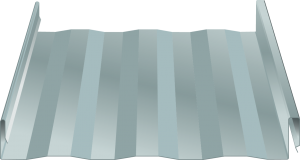Avoiding Oil Canning With Standing Seam Steel for Barndominiums and Post Frame Buildings
As post frame construction grows by leaps and bounds into post frame homes (barndominiums and shouses), more clients look to them for upgraded features. Standing seam roofing may appeal to some who appreciate the aesthetics of no visible screw fasteners.
 Standing seam roof, or SSR as it is commonly abbreviated, has a profile of flat panels intersected with evenly spaced vertical legs or seams. Fastenings are concealed on these panels – hence why this profile is commonly called “concealed fastener”. SSRs can be attached to 5/8” plywood roof decks with a fastening flange.
Standing seam roof, or SSR as it is commonly abbreviated, has a profile of flat panels intersected with evenly spaced vertical legs or seams. Fastenings are concealed on these panels – hence why this profile is commonly called “concealed fastener”. SSRs can be attached to 5/8” plywood roof decks with a fastening flange.
Fasteners are driven into roof deck without piercing metal panels. (In order to maintain a building’s structural integrity, a plywood roof deck is required: https://www.hansenpolebuildings.com/2015/08/standing-seam-steel/). All fasteners are then hidden within standing seams. Thus, panels are locked together by snap-fit seam geometry. SSRs come in a multitude of shapes and sizes, single-folded, double-folded, T-Shaped, even Bulb-Shaped. Industry consensus favors standing seam, for its higher quality, ability to respond to “thermal cycling” and aesthetic design.
Sidebar – I am actually having our fourth generation family home outside of Spokane, Washington reroofed with SSR panels! Yes me, who has specified, sold and/or installed tens of millions of square feet of through screwed steel!
While material and finish warranties are generally equal, most standing seam systems are offered with better entire system warranties. Some manufacturers also offer extended assurance their roofs won’t leak (weather-tightness warranty) over some given period of time. Absence of exposed fastening lends itself to a much lower possibility of leakage as compared to exposed fastener systems where thousands of screw fasteners with EPDM washers are subject to installation error and because they penetrate weathering surfaces, and “pin” panels to roof purlins.
Exposed Fastener (EF) roofs involve driving screws through panels and directly into roof purlins, remaining visible. Keep in mind, properly installed these screws will never leak (https://www.hansenpolebuildings.com/2019/01/solving-steel-roofing-leaks/).
EF roofs are less expensive than standing seam systems. Lower cost comes from these panels being able to be manufactured with thinner gauge and wider-dimensioned panels, reducing material handling aspects of installation. This generally means less roofing material is needed overall and thinner panels typically cost less. Additionally, EF roofs don’t require use of expensive plywood decking and 30# felt (or an ice and snow shield) further reducing costs (i.e. fewer components, and cheaper to install so overall total cost of roof is less).
EF roofs do still offer substantial protection against harsh weather elements. But it is important to note industry standards for standing seam versus exposed fastener are not necessarily equal. So, for example, wind uplift testing may or may not have been performed on EF roof profiles. Also, don’t expect weather-tight warranties to be included. Holes are required to secure roof attachment to purlins – a process more prone to installation error. It’s not called an exposed fastener roof for nothing.
SSRs require more finesse during installation. Common exposed fastener roof panels DIY project-ready for weekend warriors.
I have always had an aesthetic complaint with SSR roofing – it oil cans. Oil canning is a perceived waviness in flat areas of steel panels. Generally “period” and “amplitude” (in layperson’s terms – frequency and size) of waves depends upon continuous width of flat portion of panel.
Mason from Metal Roofing University provides quick tips to avoid oil canning of SSRs:
https://www.youtube.com/watch?v=AWSGFoSOdRU.
As much as aesthetics are touted with standing seam roofs, this lack of hidden fasteners on roofs is still appealing to many for practical reasons. If cost, ease of installation, and a need to match it to surrounding buildings are aspects you are weighing in your decision, then EF might be a good choice.
It is always advisable to perform routine maintenance on any roof (metal or other). One should still remove debris, clean gutters, remove stains, scan for scratches, and check for trouble-spots for potential corrosion.
Standing seam and exposed fastener are distinctly different concepts for metal roofing. Ultimately these two steel roofing options serve different purposes depending on location, weather, design, and more. Aesthetically-speaking and weather-wise, standing seam offers secure zero-panel-penetration as well as a long-lasting roofing solution. If cost is a big one for you, and you are also considering installing it yourself, exposed fastener may be a smart choice.






